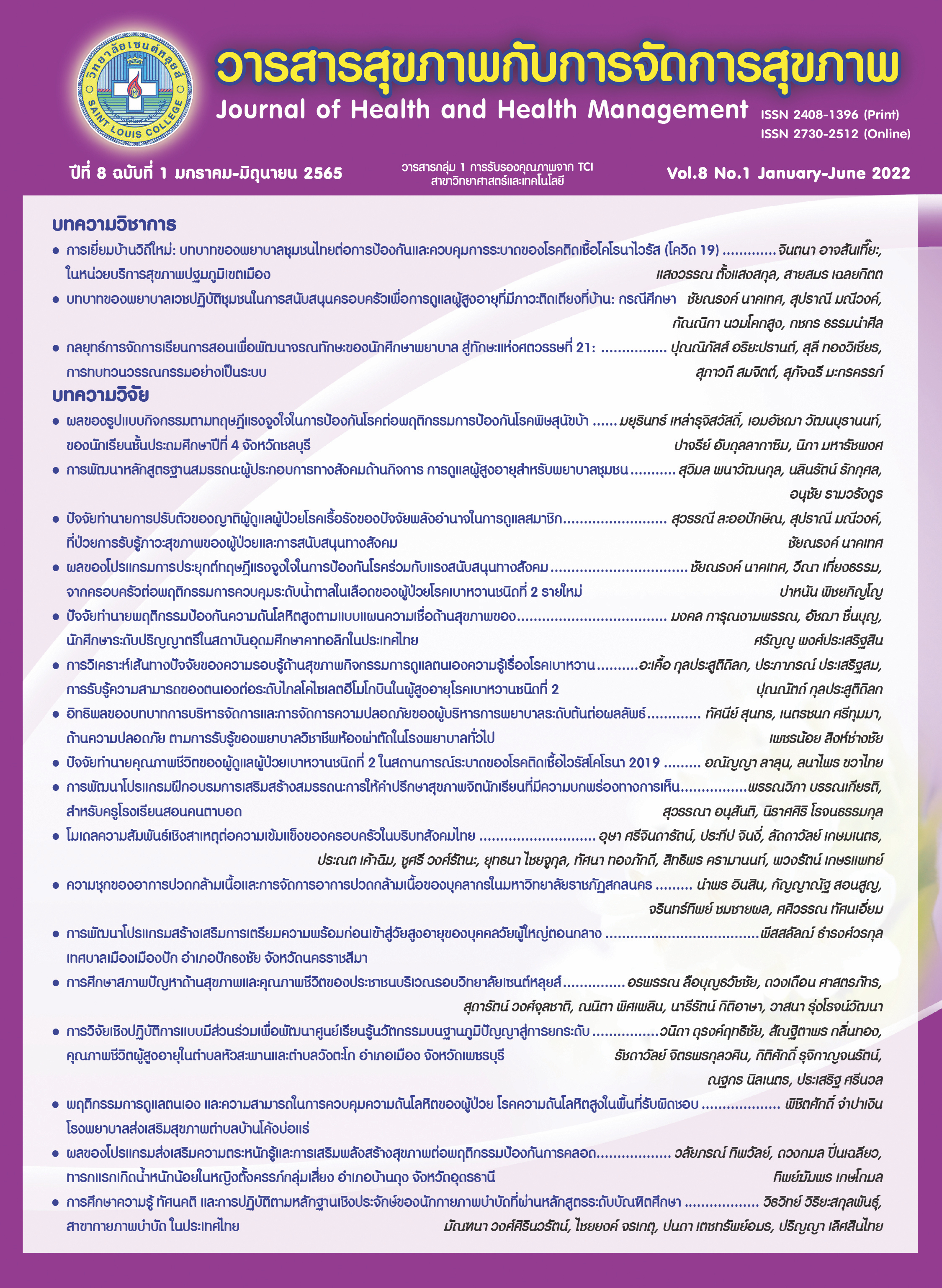The Effect of Application of Protection Motivation Theory and Family Support in Blood Sugar Control Behavior among the New Diagnosed DM Type II
Keywords:
New diagnosed DM type II, Protection motivation theory, family supportAbstract
This two-group quasi-experimental research using pre-test, post-test and follow - up design, aimed to study the effect of the application of protection motivation theory and family supports in blood sugar control behaviors among the new diagnosed DM type II. The sample was 64 type II diabetic patients in Bangkok, who were equally divided into two groups: an experimental group and comparison group. The research was conducted over a period of 8 weeks, 4 weeks were allotted for the intervention and another 4 weeks were provided for follow-up period. The experimental group was given the programs which consisted of educational sessions in a group discussion on the 1st week and followed-up by telemonitoring on the 2nd and the 3rd week. Onward, the data were collected in the post-test phase on the 4th week and follow-up phase on the 8th week. The questionnaire had been developed by the researcher’s form related to prior literatures. All items are four rating scale questions (CVI = 0.92, Reliability = 0.90). Measuring was in the pre-test, post-test, and follow-up period. The statistical analysis was performed by using percentages, means, standard deviations, Chi-square tests, repeated measure ANOVA, and Independent t-test. The results found that the mean scores of the blood sugar control behaviors and blood sugar in the experimental group after the intervention were better than pre-experimental and the comparison group with statistical significance at p < .05.
References
กระทรวงสาธารณสุข. (2563). Health Data Center(HDC). สืบค้นจาก https://hdcservice.moph.go.th/hdc/reports/report.php?source=pformated/format1.php&cat_id=6a1fdf282fd28180eed7d1cfe0155e11&id=eeeab22e386d32e7f5f5ecefebce0001
กองโรคไม่ติดต่อ กระทรวงสาธารณสุข. (2561). จำนวนและอัตราผู้ป่วยในปี 2559-2561 (เบาหวาน). สืบค้นจาก http://www.thaincd.com/2016/mission/documents-detail.php?id=13684&tid=32&gid=1-020
คณิตตา อินทบุตร, สุรินธร กลัมพากร, และปาหนัน พิชยภิญโญ. (2560). ผลของโปรแกรมการจัดการตนเองร่วมกับแรงสนับสนุนทางสังคมในผู้ป่วยเบาหวานชนิดที่ 2 รายใหม่ ที่ควบคุมระดับน้ำตาลในเลือดไม่ได้. วารสารพยาบาลสาธารณสุข, 31(2), 11-27.
ดวงหทัย แสงสว่าง, อโนทัย ผลิตนนท์เกียรติ, และนิลาวรรณ งาขํา. (2561). ปัจจัยที่มีผลต่อพฤติกรรมการลดระดับน้ำตาลในเลือดของผู้ป่วยโรคเบาหวาน โรงพยาบาลส่งเสริมสุขภาพตำบลบางปูใหม่ จังหวัดสมุทรปราการ.วารสารวไลยอลงกรณ์ปริทัศน์ (มนุษยศาสตร์และสังคมศาสตร์), 8(1), 103-117.
เทพ หิมะทองคำ, รัชตะ รัชตะนาวิน, และธิดา นิงสานนท์. (2557). ความรู้เรื่องโรคเบาหวานฉบับสมบูรณ์(พิมพ์ครั้งที่ 3). กรุงเทพฯ: บริษัทวิทยพัฒน์ จำกัด.
นวลอนงค์ ศรีสุกไสย. (2556). ความสัมพันธ์ระหว่างการทำหน้าที่ของครอบครัว การรับรู้การสนับสนุนจากครอบครัวกับพฤติกรรมการดูแลตนเองของผู้ป่วยเบาหวานชนิดที่ 2 ในเขตอำเภอบ้านโป่ง จังหวัดราชบุรี. วารสารพยาบาลกระทรวงสาธารณสุข, 23(1), 60-69.
วิชัย ศรีผา. (2557). ผลของการประยุกต์ทฤษฎีแรงจูงใจเพื่อป้องกันโรคร่วมกับแรงสนับสนุนทางสังคมในการปรับเปลี่ยนพฤติกรรมของผู้ป่วยเบาหวาน อำเภอโซ่พิสัย จังหวัดบึงกาฬ. วารสารการพยาบาลและสุขภาพ, 8(3), 268-278.
วีณา เที่ยงธรรม, จันทิมา เนียมโภคะ, อาภาพร เผ่าวัฒนา, และสุธรรม นันทมงคลชัย. (2554). ผลของโปรแกรมสร้างเสริมสุขภาพสำหรับผู้ป่วยโรคเบาหวานชนิดที่ 2 ที่ไม่สามารถควบคุมระดับน้ำตาลในเลือด. วารสารสาธารณสุขศาสตร์, 41(2), 149-160.
วีณา เที่ยงธรรม, สุนีย์ ละกําปั่น, และอาภาพร เผ่าวัฒนา. (2557). การพัฒนาศักยภาพชุมชน: แนวคิดและการประยุกต์ใช้(พิมพ์ครั้งที่ 4 ฉบับปรับปรุงครั้งที่ 2).กรุงเทพฯ: บริษัท แดเน็กซ์ อินเตอร์คอร์ปอเรชั่น จำกัด.
สำนักงานหลักประกันสุขภาพแห่งชาติ. (2559). คู่มือบริหารงานงบกองทุน หลักประกันสุขภาพแห่งชาติ ปีงบประมาณ 2560 (พิมพ์ครั้งที่ 3). กรุงเทพฯ: ห้างหุ้นส่วนจำกัดแสงจันทร์การพิมพ์.
American Diabetes Association. (2019). Standards of Medical Care in Diabetes -2019. The journal of clinical and applied research and education, 42(1), 1-193. https://doi.org/10.2337/dc19-S016
Conner, M. & Norman, P. (2005). Predicting Health Behavior (2nd).New York: UK by Bell &Bain Ltd, Glasgow.
Cohen, J. (1988). Statistical Power Analysis for the Behavioral sciences. (2nd). New Jersey: Lawrence Erlbaum Associates, Inc.
House, J. S. (2001). Social isolation kills, but how and why?. Psychosomatic medicine, 63(2), 273-274. https://doi.org/10.1097/00006842-200103000-00011
International Diabetes Federation. (2019). IDF Diabetes Atlas 9th edition 2019. Western Pacific. Retrieved from https://www.diabetesatlas.org/upload/resources/material/20200302_133351_IDFATLAS9e-final-web.pdf
Jantraporn, R., Pichayapinyo, P., Lagampan, S., & Mayurasakorn, K. (2019). Effects of carbohydrate reduction program and telemonitoring on glycosylated hemoglobin in patients with poorly controlled type 2 diabetes: a randomized controlled trial. Journal of the Medical Association of Thailand, 102(5), 523-529.
Rogers, R. W. (1983). Cognitive and physiological processes in fear appeals and attitude change: A revised theory of protection motivation. In J. T. Cacioppo & R. E. Petty (Eds.), Social psychophysiology: A sourcebook. New York: Guilford.
Downloads
Published
How to Cite
Issue
Section
License
Copyright (c) 2022 Journal of health and health management

This work is licensed under a Creative Commons Attribution-NonCommercial-NoDerivatives 4.0 International License.




